Schulz: All of the things that you see in the strip, if you were to read it every day and study it, you would know me.
Rose: To read your characters is to know you.
Schulz: Isn’t that depressing?
Good grief. David Michaelis’s Schulz and Peanuts. A grueling 565 pages of book that exhausted and disappointed me. So many details, so many of them not significant. I never get sick of Peanuts, but by the end of the book, I was sick of Charles Schulz.
Jeet Heer has written a really brilliant post about the strengths and flaws of the book, almost 100% of which I agree with. Jeannie Schulz and the Schulz kids have also been really outspoken about the fact that the book, in their opinion, is just downright wrong.
Whether it’s factually inaccurate or not, I didn’t find it to be a pleasant nor a particularly great read.
The major innovation of the book is the way Michaelis weaves examples of the strips into the autobiography. This works because—as Schulz said—to read the strip is to know him. It’s all there. This book would’ve been a helluva lot better if Michaelis ran with this technique, and just collaged the strips in a way that reflected the chronological order of Schulz’s life, stating the plain autobiographical facts alongside them, leaving out his psychological “insights.” Now THAT would be a cool book.
Here are some materials I recommend instead of the Michaelis book for those interested in Schulz and his work:
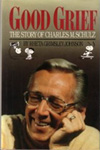 |
Good Grief: The Story of Charles M. SchulzRheta Grimsley Johnson’s underrated and unfortunately out-of-print 1989 “authorized” biography. Nobody seems to be interested in this book now that the Michaelis biography has come out, but I think it hits all the significant details and deals with Schulz’s depression in a very straightforward and explicit manner. Plus, the writing is way better. Worth tracking down. (Great Amazon customer review.) Check out an excerpt from the book in my post, THE TWELVE DEVICES OF PEANUTS. |
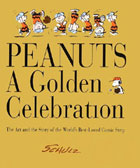 |
Peanuts: A Golden CelebrationProbably the best introduction to the strip: contains, for better or worse, strips from all five decades, including commentary here and there by Schulz himself. It’s a big, coffee-table size book, and about 200 or so pages. You can get it used for dirt cheap. (Even better might be an earlier edition, Peanuts Jubilee, but I think it’s pretty hard to get a hold of…) |
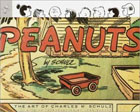 |
Peanuts: The Art of Charles M. SchulzChip Kidd designed this beautiful little book. It concentrates on the early part of the strip’s life and development, and contains numerous beautiful scans of actual newspaper clippings (a lot which come from the personal collections of Kidd and Chris Ware) and photographs of Schulz’s tools. |
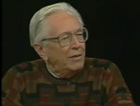 |
ON THE CHARLIE ROSE SHOWThis is a good interview with Schulz from near the end of his life, and you can watch the whole thing for free. |
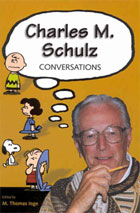 |
Charles M. Schulz: ConversationsThis is a great book which includes Gary Groth’s excellent, 100+ page interview for the Comics Journal. |
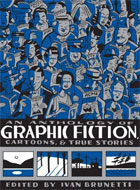 |
An Anthology of Graphic Fiction, Cartoons, and True StoriesThis might seem like an odd choice, but Ivan Brunetti includes a whole slew of Peanuts tributes, including a piece penned by Schulz himself on how to be a cartoonist. |
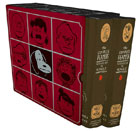 |
THE COMPLETE PEANUTSFinally, if you really want to know the man, just read his strips. Fantagraphics has done an amazing job with these books — I’ve been slowly building my set. (And I’m hoping, hoping, hoping, that they will chose to release it on DVD at some point, a la The New Yorker.) |
If any of you dear readers read the book, I’d love to hear your thoughts.
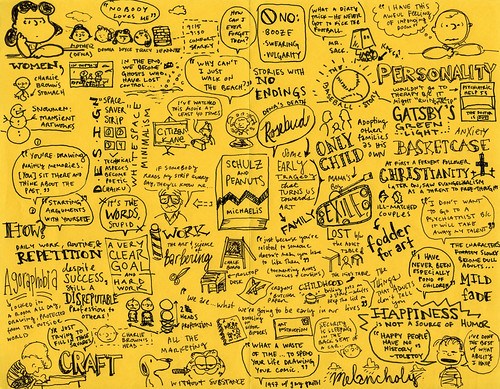
More thoughts:
1) Why, in the internet age, would you include 60 pages of near unreadable and abbreviated source notes when you could simply post them all on a webpage, saving valuable paper and book poundage? (Drew Westen did this for his book THE POLITICAL BRAIN, and I thought it worked great.)
2) The NYTimes Obituary is probably the best introduction: http://www.nytimes.com/library/arts/021400obit-c-schulz.html
I just started reading your site here, great stuff. I love the mindmap (?), did you draw it on the inside cover of the book? I noticed a crease running down the center.
Hey Lee! No, I didn’t draw on the inside cover (but that’s a good idea!) What I usually do is just stick a piece of plain paper in whatever new book I’m reading, and use it for the map and a bookmark. That way I don’t have to carry around an extra notebook.
I found this ugly yellow paper in a desk drawer, and thought of Charlie Brown’s shirt.